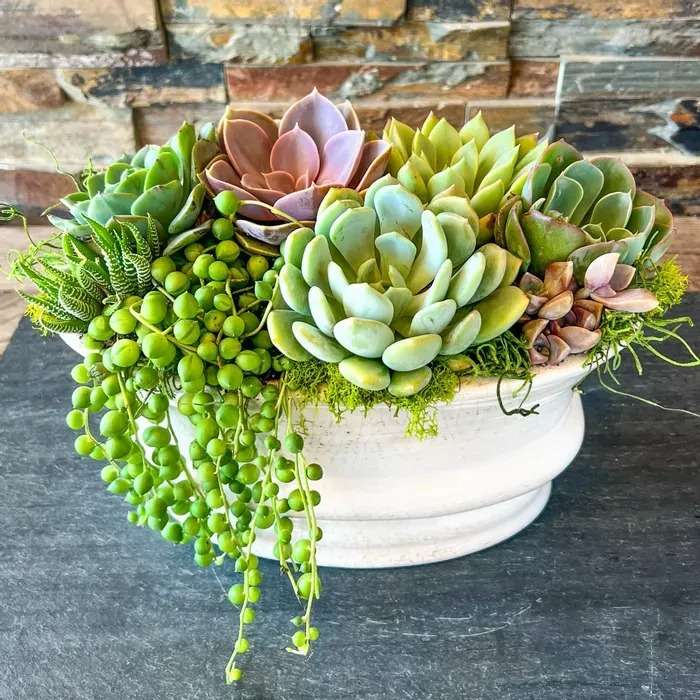Succulent plants have gained popularity in recent years due to their unique and beautiful appearance, as well as their ability to thrive in various environments. One way to enhance the growth and health of your succulent garden is by using coffee grounds as a natural fertilizer. Coffee grounds are rich in nutrients that can improve soil quality and promote plant growth. In this article, we will explore the benefits of using coffee grounds in your succulent garden and provide tips on how to maximize their effectiveness.
Understanding the Nutritional Value of Coffee Grounds for Succulents
Coffee grounds contain several essential nutrients that are beneficial for succulent plants. Nitrogen, phosphorus, and potassium are the primary nutrients found in coffee grounds. Nitrogen is essential for promoting leafy growth and overall plant health. Phosphorus aids in root development and flower production, while potassium helps with disease resistance and water regulation within the plant.
These nutrients are released slowly into the soil when coffee grounds are used as a fertilizer, providing a steady supply of nourishment for your succulents. Additionally, coffee grounds are slightly acidic, which is beneficial for succulents that prefer a slightly acidic soil pH.
How to Prepare and Apply Coffee Grounds to Your Succulent Plants
To prepare coffee grounds for use in your succulent garden, start by collecting used coffee grounds from your daily brew. It’s important to note that fresh coffee grounds can be too acidic for succulents, so it’s best to use used grounds that have been allowed to cool and dry out.
Once you have collected enough coffee grounds, mix them with equal parts of organic compost or potting soil. This will help balance the acidity of the coffee grounds and provide additional nutrients for your succulents.
When applying coffee grounds to your succulent plants, sprinkle a thin layer around the base of each plant, being careful not to cover the leaves or stems. It’s important not to overdo it with coffee grounds, as too much can lead to nutrient imbalances and root burn. A thin layer applied once every few months is sufficient to provide the necessary nutrients for your succulents.
The Dos and Don’ts of Using Coffee Grounds in Your Succulent Garden
While coffee grounds can be beneficial for your succulent garden, it’s important to follow some best practices to ensure optimal results. Here are some dos and don’ts when using coffee grounds as a fertilizer:
Do:
– Use used coffee grounds that have been allowed to cool and dry out.
– Mix coffee grounds with equal parts of organic compost or potting soil.
– Apply a thin layer of coffee grounds around the base of each plant once every few months.
Don’t:
– Use fresh coffee grounds, as they can be too acidic for succulents.
– Apply coffee grounds directly on the leaves or stems of your succulents.
– Overuse coffee grounds, as this can lead to nutrient imbalances and root burn.
By following these dos and don’ts, you can ensure that your succulent plants receive the right amount of nutrients from the coffee grounds without causing harm.
Tips for Maximizing the Benefits of Coffee Grounds on Your Succulent Plants
To maximize the benefits of using coffee grounds in your succulent garden, consider incorporating them into your regular gardening routine. Here are some tips to help you get the most out of coffee grounds:
1. Use in conjunction with other natural fertilizers: While coffee grounds provide essential nutrients for your succulents, they should not be the sole source of fertilizer. Consider using other natural fertilizers, such as compost or worm castings, to provide a well-rounded nutrient profile for your plants.
2. Monitor plant growth: Keep an eye on how your succulents are responding to the coffee grounds. If you notice signs of nutrient deficiencies or excesses, adjust the amount of coffee grounds you are using accordingly. Every plant is different, so it’s important to pay attention to their individual needs.
3. Compost coffee grounds: If you have the means to compost, consider adding coffee grounds to your compost pile. This will help break down the coffee grounds further and release their nutrients slowly over time. Compost can then be used as a natural fertilizer for your succulents.
Other Natural Fertilizers and Compost Options for Succulent Gardening
While coffee grounds are an excellent natural fertilizer for succulent plants, there are other options available as well. Here are some other natural fertilizers and compost options that can be used in succulent gardening:
1. Compost: Compost is a mixture of organic matter that has decomposed over time. It is rich in nutrients and beneficial microorganisms that can improve soil quality and promote plant growth. Adding compost to your succulent garden can provide a well-rounded source of nutrients for your plants.
2. Worm castings: Worm castings, also known as vermicompost, are the waste produced by earthworms. They are rich in nutrients and beneficial microorganisms that can enhance soil fertility and plant health. Adding worm castings to your succulent garden can provide a slow-release source of nutrients for your plants.
3. Fish emulsion: Fish emulsion is a liquid fertilizer made from fish waste. It is high in nitrogen, phosphorus, and potassium, making it an excellent choice for promoting healthy growth in succulent plants. Fish emulsion can be diluted with water and applied directly to the soil or used as a foliar spray.
Common Mistakes to Avoid When Using Coffee Grounds in Your Succulent Garden
While using coffee grounds as a natural fertilizer can be beneficial for your succulent garden, there are some common mistakes to avoid. Here are a few mistakes to watch out for:
1. Using uncomposted coffee grounds: Fresh coffee grounds can be too acidic for succulents and may contain compounds that can be harmful to plants. It’s important to use coffee grounds that have been allowed to cool and dry out, or better yet, composted.
2. Applying too much at once: Coffee grounds should be applied in moderation. Applying too much at once can lead to nutrient imbalances and root burn. A thin layer applied once every few months is sufficient to provide the necessary nutrients for your succulents.
3. Not mixing with other fertilizers: While coffee grounds are a great source of nutrients, they should not be the sole source of fertilizer for your succulent plants. It’s important to mix coffee grounds with equal parts of organic compost or potting soil to provide a well-rounded nutrient profile.
By avoiding these common mistakes, you can ensure that your succulent plants receive the right amount of nutrients from the coffee grounds without causing harm.
The Environmental Benefits of Using Coffee Grounds in Your Garden
Using coffee grounds in your garden not only benefits your plants but also has environmental advantages. By using coffee grounds as a natural fertilizer, you are reducing waste and promoting sustainable gardening practices. Instead of throwing away used coffee grounds, you are repurposing them and giving them a second life in your garden.
Coffee grounds are a rich source of organic matter, which helps improve soil structure and water retention. By incorporating coffee grounds into your garden, you are enriching the soil and creating a healthier environment for your plants.
Furthermore, using organic and natural fertilizers like coffee grounds reduces the need for synthetic chemicals that can harm the environment. By choosing natural fertilizers, you are promoting a more sustainable approach to gardening that is beneficial for both your plants and the planet.
Success Stories: Real-Life Examples of Coffee Grounds Boosting Succulent Growth
Many gardeners have experienced success in using coffee grounds to boost the growth and health of their succulent plants. Here are a few real-life examples of how coffee grounds have made a positive impact:
1. Sarah, a succulent enthusiast, noticed that her plants were not growing as well as she had hoped. After doing some research, she decided to incorporate coffee grounds into her gardening routine. Within a few months, she noticed a significant improvement in the growth and vibrancy of her succulents. The coffee grounds provided the necessary nutrients for her plants to thrive.
2. John, an avid gardener, had been struggling with root rot in his succulent garden. He decided to try using coffee grounds as a natural remedy. By mixing coffee grounds with his potting soil and applying them around the base of his plants, he was able to improve soil drainage and prevent further root rot. His succulents began to recover and showed signs of healthy growth.
3. Lisa, a beginner gardener, was looking for ways to enhance the growth of her succulent garden without using synthetic fertilizers. She came across the idea of using coffee grounds and decided to give it a try. To her surprise, her succulents started growing faster and producing more flowers. The coffee grounds provided the necessary nutrients for her plants to thrive, and she was thrilled with the results.
These success stories highlight the positive impact that coffee grounds can have on succulent growth and health. By incorporating coffee grounds into your gardening routine, you too can experience these benefits.
Conclusion: How to Incorporate Coffee Grounds into Your Succulent Gardening Routine
Incorporating coffee grounds into your succulent gardening routine can provide numerous benefits for your plants and the environment. Coffee grounds are rich in essential nutrients that promote healthy growth and improve soil quality. By following the dos and don’ts of using coffee grounds, you can ensure that your succulents receive the right amount of nutrients without causing harm.
Additionally, consider using coffee grounds in conjunction with other natural fertilizers and compost options to provide a well-rounded nutrient profile for your succulent plants. Monitor plant growth and adjust coffee ground usage accordingly to ensure optimal results.
By using coffee grounds in your garden, you are not only enhancing the growth and health of your succulent plants but also promoting sustainable gardening practices. So why not give it a try? Incorporate coffee grounds into your succulent gardening routine and enjoy healthier, more vibrant plants.
If you’re a succulent lover, you may be wondering if coffee grounds are good for your plants. According to a related article on GirlsGist, coffee grounds can actually benefit succulents in several ways. They provide nutrients like nitrogen, potassium, and phosphorus, which are essential for plant growth. Coffee grounds also improve soil drainage and aeration, preventing root rot and other moisture-related issues. To learn more about how to use coffee grounds for your succulents, check out the article here.

















Add Comment